My Favorite Board Games
November 1, 2013 - Games
It's likely no secret that over the past couple years, board games are definitely my thing. I've thrown together a list of my ten favorites, and I'd like to share them with you here and now.
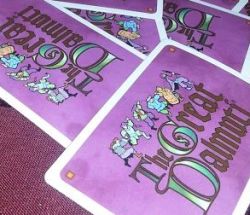 10 - The Great Dalmuti
10 - The Great Dalmuti
Although it's just a variant of a public domain card game that's apparently existed for hundreds of years, Dalmuti is a fantastic game for a large crowd in a party situation. If you've got eight players, I suggest pulling out Dalmuti.
It's based on the notion of social class. At the game's outset, players are randomly assigned their social class, with the highest ones being "The Great Dalmuti" and "The Lesser Dalmuti" - those two sit in the nicest chairs you've got. The lowest players on the totem pole are "The Greater Peon" and "The Lesser Peon". They get some lousy folding chairs or stools to sit on, or better yet - a box.
Peons must pay a tax (their best cards) to the Dalmutis, and the game progresses, with the top players each round ending up as the new Dalmutis, and those who do worst becoming the new peons. With the influence of the taxes and the fact that turn order goes from Dalmuti down to Peon, the Dalmutis often stay in that role, as do the Peons.
You can watch a demo of The Great Dalmuti being played here.
9 - Castle Panic
Castle Panic is a cooperative tower defense board game. When we first saw that a few years back at PAX East, we couldn't check that game out of the board game library fast enough. Although we all (barely) lost that first game, once we got used to how to play, winning became easy. Because of this, I'd recommend the base game for parents who want to play something fun with their kids.
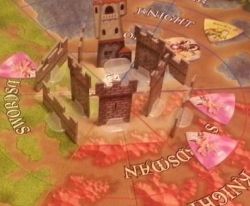 If you want a challenge, pick up the expansion. Yow. It's hard. I've played it almost exclusively with my daughter, and I suspect that the game might be a bit easier with more than two players, but right about now, we've got something like a 25% win ratio. But even though we lose more often than not, the game is a lot of fun.
If you want a challenge, pick up the expansion. Yow. It's hard. I've played it almost exclusively with my daughter, and I suspect that the game might be a bit easier with more than two players, but right about now, we've got something like a 25% win ratio. But even though we lose more often than not, the game is a lot of fun.
Castle Panic was featured on an episode of Geek and Sundry's Tabletop, and you can watch the show here.
8 - Lost Cities
I discovered Lost Cities less than a year ago at The Gathering of Friends in Buffalo. It's a card game about funding and mounting expeditions to five different color-coded destinations. Although the cards are in essence just numbers 1-10 and a few modifiers, the art is beautiful and the mechanics are simple and brilliant.
The play comes in deciding which and how many expeditions to undertake, and given that you must play or discard a card each turn, you often don't have the chance to wait in order to make a decision. You'll nearly always wish you'd made a different decision, but early on you don't have all the information with which to decide.
Lost Cities is a two-player only game, and for that reason I've heard it referred to as a couples game. That's my own favorite way to play. You can watch Lost Cities being played here.
7 - Elder Sign
Firmly based in H.P. Lovecraft's Cthulhu mythos, Elder Sign is a cooperative adventure game that I've often heard compared to Yahtzee. It's got a lot of similarity to Arkham Horror, but plays in roughly half the time.
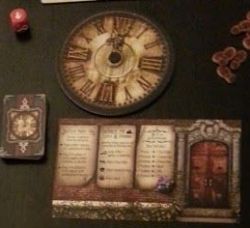 Players in Elder Sign must investigate a museum and locate a certain number of relics known as Elder Signs in order to seal away a Greater Old One before he appears and devours the world. This is done through different adventures, each of which is a card with various goals. These are accomplished by rolling dice to match various symbols. However, some must be done in a specific order, others lock away certain dice, and many have significant penalties to your character's health or sanity should you fail. You can undertake certain easier adventures to gain items and spells that will help you better tackle the more difficult adventures, or open portals to otherworldly realms in which you may stand a chance to locate yet more Elder Signs.
Players in Elder Sign must investigate a museum and locate a certain number of relics known as Elder Signs in order to seal away a Greater Old One before he appears and devours the world. This is done through different adventures, each of which is a card with various goals. These are accomplished by rolling dice to match various symbols. However, some must be done in a specific order, others lock away certain dice, and many have significant penalties to your character's health or sanity should you fail. You can undertake certain easier adventures to gain items and spells that will help you better tackle the more difficult adventures, or open portals to otherworldly realms in which you may stand a chance to locate yet more Elder Signs.
The game is a lot of fun, although a fair amount of the time, everyone at the table loses. If you're interested in watching the episode of Tabletop in which they play Elder Sign, you can watch here.
6 - Robo Rally
In Robo Rally, you control your robot by placing a number of order cards such as "Move Forward 2 spaces", "Turn Left", or "U-Turn". You place five at a time out of an initial hand of 9 cards in order to navigate your robot through a series of hazards such as pits, conveyor belts, spinners, pushers, and lasers. It's easy to miscalculate as a result of landing on a spinner and facing a different direction than you'd planned, or miscounting how many spaces the conveyor belt would move you after your third card. Or, another robot might move where you didn't expect and push you two spaces over, changing where you end up for the remainder of your turn.
I hesitate to use the term zany. Zany is not a term I use. But gameplay when you get a larger number of players can get hectic. And the game plays with up to eight. I don't think I've ever played with more than four, but I'd really like to.
You can watch a video review of Robo Rally here.
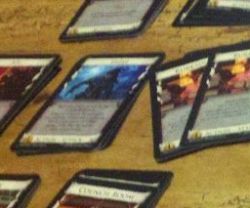 5 - Dominion
5 - Dominion
It's been called the godfather of deck-building games. I didn't get into Dominion until having played it at PAX East, but after I played it I had to get a copy. I love the game. Since you're only using ten different card types each time you play, there's a lot of replayability.
If you don't know what a deck-building game is, I'll try for a concise description. Each player begins with the same ten-card hand, and over the course of the game purchases cards from the ten stacks available and adds the purchased card to his or her personal discard stack. After each player's hand is exhausted, he or she reshuffles discarded cards and draws five more into a new hand. In this way, each player is building their own personalized deck.
The cruz of the thing is that in order to win, you need points cards, but buying those too early can really cause you a problem, since those cards are useless during play. If you end up with a hand of five cards that are worth points, there are literally no actions you can take. As a result, players usually spend the first half of the game building up, and the second half buying points, which then dilute their decks less since players have more cards. Yeah - the tactics go pretty deep. But it's easy to learn! You can learn more about Dominion from this video.
4 - Betrayal at the House on the Hill
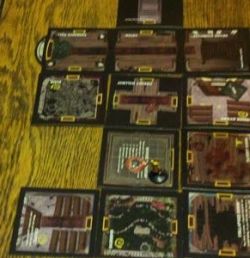 I'd been saying for a long time that Betrayal at the House on the Hill was flat-out my favorite game. But while it's certainly amongst my favorites, I manager to find three others here that I love even more.
I'd been saying for a long time that Betrayal at the House on the Hill was flat-out my favorite game. But while it's certainly amongst my favorites, I manager to find three others here that I love even more.
Anyway, Betrayal is a fantastic game. It's got fifty different plots, so it's going to be a completely different game every time you play. The premise is that of a B-budget horror movie, and it's got all the tropes: werewolf, vampire, demons, mummy, as well as less common ones like Dorian Gray.
The game starts out with each player choosing a character - and there are color-painted miniatures for each character - and beginning to explore the house. As you explore, you can find items that may help or enhance your character's abilities. You also help to build the mansion's layout. At a certain point in the game, the traitor will be revealed, and one of the players finds out that it's him or her versus everyone else. From there, either the traitor wins or else everyone else wins. So it might be that the traitor is controlling Frankenstein's monster, or else perhaps he's the one summoning hellbats through a gate from hell that the other players must close.
The wealth of scenarios brings to mind the ending of Cabin in the Woods. It's fantastic, and the rules for every playthrough are different - it's that constant freshness that keeps this game so high on my list.
The Tabletop crew played Betrayal at the House on the Hill in the most recent two episodes of Tabletop. You can watch the first of them here.
3 - Descent: Journeys in the Dark
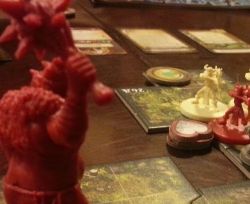 Descent is very much a board game version of Dungeons and Dragons. There's no actual roleplaying required - it's a board game rather than an RPG - but it's got the dungeon crawl thing going, and you can improve your characters' skills and equipment over the course of a campaign. The other main difference between Descent and D&D is that in Descent, the guy running the game really is trying to kill you.
Descent is very much a board game version of Dungeons and Dragons. There's no actual roleplaying required - it's a board game rather than an RPG - but it's got the dungeon crawl thing going, and you can improve your characters' skills and equipment over the course of a campaign. The other main difference between Descent and D&D is that in Descent, the guy running the game really is trying to kill you.
The Descent campaign consists of something like 8-10 sessions, and each of those has two scenarios. Each session is perfect for an evening's play, and that's exactly what my group has been doing the last few times we've gotten together. We're now just over halfway through the campaign, and I'm loving it.
The game mechanics allow players two actions per turn: move, attack, rest, or a combination. Attacks are resolved via rolling colored dice that depend entirely on the weapon or spell used. Those dice have no numbers, but will show hearts of damage, units of range, and lightning bolts that indicate extra abilities that can be used, depending on the weapon or spell. A lot of math has been compressed into those symbol-laden dice, and the system works well.
I'm playing Grisban the drunken dwarf, our toe-to-toe fighter. My friends are playing Window Tarha (whose main ability is to summon a skeleton) and Tomble the halfling (who's incredibly valuable for his maneuverability, since movement is just about the most useful thing in the game) We've also recent taken on a fifth player - a healer whose name I can't remember, but that role was sadly lacking, and the additional help allowed the players to actually win a scenario this past gathering.
Descent isn't for everybody. But for a guy like me who grew up on D&D, it's exactly the low-key transition I need at this point in my life.
You can watch a video review of Descent here.
2 - Ninja: Legend of the Scorpion Clan
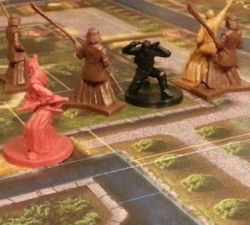 This game came at me from out of nowhere. A friend of mine bought it for his kids before he realized it was a bit too complicated for them. So we played it, twice in one night, and it immediately became a favorite of mine.
This game came at me from out of nowhere. A friend of mine bought it for his kids before he realized it was a bit too complicated for them. So we played it, twice in one night, and it immediately became a favorite of mine.
Ninja: Legend of the Scorpion Clan is a hiden movement game, and it's fantastic. You can play the game with two, three, or four players. With two, one player plays the Ninja and the Traitor, and the other plays the guards. With three you have separate players using the Ninja and Traitor, and with four you split the guards as well. We played 4-player. The Ninja and the Traitor must each accomplish a single goal such as "steal the treasure" or "poison the well", and that goal is represented by a face-down tile somewhere on the map. The goals are placed by the guard players. The guards' goal is to catch the Ninja and the Traitor before they can accomplish their goals, or to at least keep them away until sunrise, which is a specified number of turns.
Guards are limited in their movement. Patrol guards must stay on their patrol path unless they hear something, and tower guards must remain at their posts unless they hear something. The Ninja and Traitor have freedom of movement, and their movement is conducted off the actual game board, on a hidden sheet of paper behind a screen. They can each choose to move between one and three spaces each turn. The catch is that the distance they've moved is also how far they can be heard from. A ninja who runs three spaces is not being careful and quiet, and so can be heard three spaces away. The ninja who sneaks only one space likely won't be heard. The interesting thing here is that intelligent guard players can triangulate a sneaking ninja or traitor.
What makes the game even more interesting is that the spaces on the board aren't regularly sized. There are long spaces, short spaces, and L-shaped spaces. It's difficult to describe exactly how, but this complicates the gameplay and makes it even more interesting.
Players accomplish their goals by use of cards. The Ninja has cards which can kill a guard instantly and quietly, or the shuriken which can kill a guard at distance. The guard player will know that his guard has been killed, but since no noise was made, the other guards aren't allowed to deviate from their patrols. The Traitor has guards like "It was just a cat", which he can play after a guard has heard him, and "poisoned rice" which makes me very much think of the original Tenchu: Stealth Assassins game. The catch is that the ninja and the traitor choose cards at the beginning of the game, and after they're used, they're gone.
Guards, on the other hand, can replenish their cards. This is absolutely key to playing the guards. When guards see or hear something suspicious, the alert level goes up, which lets the guards take more cards. Those listen cards are important to triangulating hidden foes. And since hearing something is what allows the guards to deviate from their paths or posts, they're even more important.
It's been a long time since I played this game, and I did only play the one night so I may be remembering some of the rules incorrectly, but this is the gist. You can watch a video review of Ninja: Legend of the Scorpion Clan here.
1 - Starcraft
But out of all of these, the game that's probably my favorite is the board game version of a video game. What makes the Starcraft board game so excellent is that it replicates the asymmetric nature of the three separate races from the video game and does so using mechanics that could never exist in a video game yet work perfectly for a board game. The Starcraft board game has tech trees, deck-building, and strategic movement. It uses elements from the video game such as supply structures and unit limits, workers mining minerals and gas, and even transports.
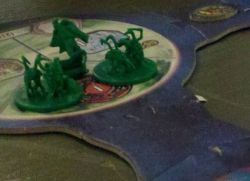 Starcraft has a lot of complexity. The first time I played, I was nearly turned off by how complicated certain aspects were. But once things clicked, I realized just how well everything works.
Starcraft has a lot of complexity. The first time I played, I was nearly turned off by how complicated certain aspects were. But once things clicked, I realized just how well everything works.
One of the core elements of the game is how orders are issued. The first turn marker is passed from player to player, and each player can place four orders on any planet they choose. Available orders are Build, Move, and Research. So if I were going first, I might want to build units and then move them onto a different planet. The trick is that orders are placed in a stack, so they play out in reverse order - if you want something to happen last, you play that order first. And anyone can place orders on any planet, which means that other players can place an order on top of yours in a stack, thus covering up your order. In that case, you can't execute that order until after they execute theirs. You'll have many planets to choose from, and placing an order you don't intend to use so that you can force another player to wait is a perfectly legitimate move. This takes a while to get a good grip on, and we're still constantly making mistakes even after having played the game upwards of a dozen times.
The deck-building comes into play with the combat deck. Similar to Dominion, players have a hand, and a deck. Over the course of the game, minerals and gas can be spent not only on units, but on upgrades. You can look through your technology deck and add purchased cards from there into your combat deck. These cards might allow your Zerglings to burrow, your science vessel to irradiate, or your Ghost to nuke opponents. An attacker always draws more combat cards into his hand, giving an agressor the advantage.
Battles are conducted by lining up all available units into individual skirmishes - the attacker determines which units face which other units. There are certain units designated as "support" (e.g. Zerg queen or defiler, Terran science vessel) which have no attack value in face-to-face combat but can act as support and use special abilities. Players can then use cards from their combat deck - one card per skirmish - and play them face-down. Each card shows a unit or units on the front, and playing a card with the appropriate unit always gives an improved attack or defense result. Once cards have been selected by both players, they're revealed simultaneously and attack and defense values are compared. It should also be noted that many units (zergling, zealot) cannot target flying units. It's possible for two units to kill each other, or for both to survive, which forces the attacker to retreat.
The game is difficult to describe - I hope I've done a decent job, but the game is seriously complex. I love it. You can watch an overview here.
So that's a list of my current favorite board games. Feel free to leave a comment and let me know about yours.